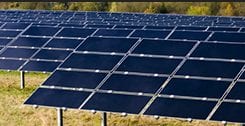Infigen Energy has switched on an experimental 200kW solar PV plant in NSW that it says will be a trial to see how solar energy, wind energy and battery storage can possibly be combined in a single project.
Infigen Energy says the Capital East project, located near its Capital wind farm near Bungendore, a village near Canberra, is the first solar plant to be registered and bid directly into Australia’s National Electricity Market.
It’s also the first solar plant to be built by Infigen – which operates some 556MW of wind energy in Australia and another 1089MW in the US – but it certainly won’t be the last. It has more than 1,200MW of wind projects in the pipeline in Australia, and more than 200MW of solar projects. It also has a US solar subsidiary.
The Capital East project has been deliberately set up to test a range of solar PV installations, mounting, inverters and connections.
Bidding the output into the NEM will provide a guidance into what sort of revenues a plant can extract. That is important because renewable energy developers are finding it hard to gain power purchase agreements from the big utilities. Solar farms, like the 56MW Moree project proposed by Pacific Hydro and FRV are likely to be built on “merchant” terms.
A battery component will be installed in coming months to see how that affects bidding and revenues. And Infigen Energy will be looking to see how its output complements that of nearby wind farms.
“We think that this is a great project,” says Infigen Energy CEO Miles George. “It has helped us learn a lot about solar PV.”
The solar project is not far from the Woodlawn wind farm, which also operates on a “merchant” capacity, meaning that it earns its revenues from selling into the wholesale market operated by the NEM rather than a fixed contract with an energy user or utility.
Infigen is looking to build large scale solar PV plants both in Australia and the US. It has an application in for funding a 35MW plant with the Australian Renewable Energy Agency – and is interested to see how wind and solar can work together, and with storage.
“Solar has a different profile to wind, so it will be interesting to see – for future large scale plants – how we are able to bid those two plants in together,” George told RenewEconomy in a recent interview.
“We’d like to see to what extent we can smooth out variability of wind with solar and vice versa. We think there could be some significant benefit for us in that.”
A lot of wind generation is produced overnight, when prices are generally lower. This is particularly true in South Australia. But in other areas, including Woodlawn, a high percentage of its generation is produced during the day – from 10am to 4pm – when prices are higher.
A new study by the Lawrence Berkeley National Laboratory in the US, funded by the Department of Energy, found that solar farms in the south-west of the country earn on average around $26/MWh more than wind because of its time-of-day production.
The Berkeley study also provided an illustration of how a solar PV project can profit from co-located wind farm. 50MW Macho Spring solar PV project was built with the lowest power purchase agreement of any solar project in the US to date – just $50/MWh (It also benefits from a state production tax credit and a federal investment tax credit).
That compares to $80/MWh for the co-located 50.4MW wind project (which gets a lower state productio benefits), but it benefits from sharing the same infrastructure, including a substation.
Berkeley says the wind farm has been operating at a 29 per cent net capacity factor, compared to 26 per cent for the solar farm, but the seasonal synergies are particularly significant, because the three summer months where the solar project will produce the most coincides with the season that the wind component will produce the least. “This natural complementarity allows the two projects to more fully utilise their interconnection agreement and transmission rights,” the Berkeley researchers said.
There are five other wind-solar co-located projects in the US, and another that combines geothermal and solar. Berkeley said most of these were not planned that way, but further synergies could be tapped when hybrid projects are planned from the start.










